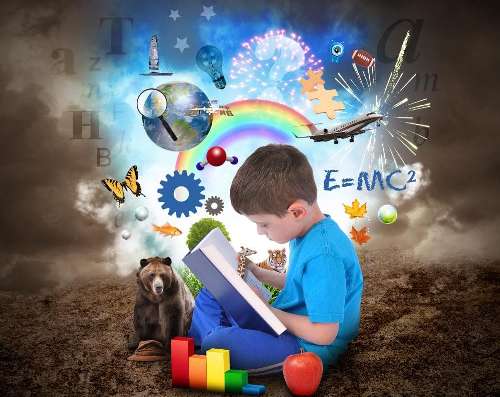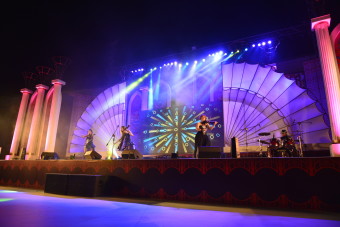Gathering Knowledge Is Fine But Creating Something With It Is Sublime
(Should It Surprise Us That The Founders of Google And Amazon Were Raised With ‘Self-Learning’?)
I recently had a heated debate with a friend.
A lawyer actually, so you can imagine the stakes were high.
I was advocating for a new type of education, where children are less reliant on passively ‘receiving information’ from teachers, and more into developing their own powers of intellectual inquiry and coming up with the answers themselves.
Basically, self-directed learning – the keystone of all good Montessori practise. But taking it beyond a Primary stage, to a Secondary one.
My friend took great umbrage to this, saying if kids could choose their own educational direction they would never really find their true path because they are not equipped to do so. “What if the kids get it wrong? And direct themselves into a dead-end? Then what?”
That was the crux of his argument. Teachers have to direct children into various disciplines, so they can make proper, informed decisions. Without them, they are lost ships in the night.
This, to me, is the old paradigm of education. At the heart of it is the idea that young people cannot be trusted to make choices, never mind good choices that propel them to fulfill their potential. They are therefore empty vessels that must be filled, not fires that must be lit. Education is brain content. It’s matter, to fill grey matter.
Maria Montessori’s pioneering work in the field of self-directed learning has spawned many great minds, including Google founders Larry Page and Sergey Brin, Amazon CEO Jeff Bezos, Gabriel García Márquez, the culinary master Julia Child, Anne Frank and Wikipedia co-founder Jimmy Wales. However, this pedagogy is over 100 years old and hasn’t yet fully integrated technology into the equation. Like any good operating system, it needs an upgrade.
Particularly relevant now is the work of Dr Sugata Mitra, an Educational Researcher from Kolkata, whose cutting-edge experiments in education have the potential to revolutionise learning in schools.
His journey began in 1999 when he was working as a Professor of Computer Studies at a university in New Delhi. He could clearly see the benefits of a privileged education in front of him with his well-to-do students, but out of the corner of his eye, he could also see poor kids milling around in the slums, with no access to decent education.
He wanted to know if he could level the odds, so he performed an audacious experiment.
He put a ‘Hole in the Wall’ computer in the slum compound. The kids didn’t know what a computer was, never mind the internet, nor could they read or speak English. Mitra offered no explanation either. He just let them get on with it. A few hours later he came back to find them merrily browsing the web and typing English phrases.
From this began a series of experiments where Dr Mitra put his Hole-in-the-Wall computers in remote villages within India to see if ‘uneducated’ children could use technology without any help. He found they could, which led him to conclude: “In 9 months, a group of children in India left alone with a computer, in any language, will reach the same standard as an office secretary in the West”.
But Mitra didn’t let it rest there. He deliberately disrupted his own argument by taking it to another level altogether.
In Kallikuppam in Southern India, he set up a street-side computer and asked the children a very important question about the biotechnology of DNA replication (which even he didn’t understand). He downloaded loads of files in English, even though they only spoke Tamil. Then he left them to it.
A few months later he returned and asked them what they had learnt – only to meet with a long deathly silence. Dr Mitra thought it was obvious; they clearly hadn’t got it. A little girl stood up and shyly said, in broken English and Tamil, ”Well, apart from the fact that improper replication of the DNA molecule causes disease, we haven’t really understood anything else.”
And then something unexpected happened.
In a short period, these children were on par with his control group – a rich private school in Delhi with a specialised Biotech teacher. They’d got there with nothing; no training, no teacher, no structure. Just a computer, the internet and a really Big Question.
Dr Mitra’s groundbreaking work has led to the creation of SOLE – Self Organised Learning Environments, which any classroom in the world can now adopt. Children are asked a Big Question, get themselves into groups around a computer, then present an answer at the end of class. They can swap groups at any time or go over and see what other people are working on. It’s not cheating, it’s sharing. A way of working which destroys the old notion that a child should sit on their own with a book or exam, recalling information in solitary confinement.
This is collaborative, exciting, energised. Learning “at the edge of chaos,” as he describes it.
The SOLE experiment has seen young children solving GCSE and A level questions before their time, understanding huge concepts like Hinduism, the Theory of Relativity or how the world began and how it might it end. Not only that, being exposed to the wider world of the internet brings new role models. Two boys who wanted to be famous footballers, watched 8 Ted Talks, and decided they’d rather be Leonardo da Vinci instead.
This is not superficial learning. They are tested a few months later to see if they can remember what they learnt and most show phenomenal recall. In fact, over time teachers have noticed that the marks get higher because children continue to explore
the questions by themselves. The flame is lit.
If children can ‘self-learn’ with such ease and grace, what are the possibilities that exist for mainstream education ? That really is the question to explore in the 21st century.
My friend’s ultimate position was this: “Well, we all turned out alright.”
In my opinion, we survived. Where would we be right now if we’d had a real educational adventure, not just years of gathering data? Maybe I’d be having this argument with Leonardo, not a lawyer.
Shilpa Mehta is the founder of Paradise School Goa, began in the South but due North in 2016. She is a former television broadcaster for Discovery, BBC and Channel 4. Her aim is to modernise education in India and the world.
Shilpa Mehta, with her daughter India-Fire






CAN’T WAIT FOR THE NEXT BREAKTHROUGH!
ASTY.